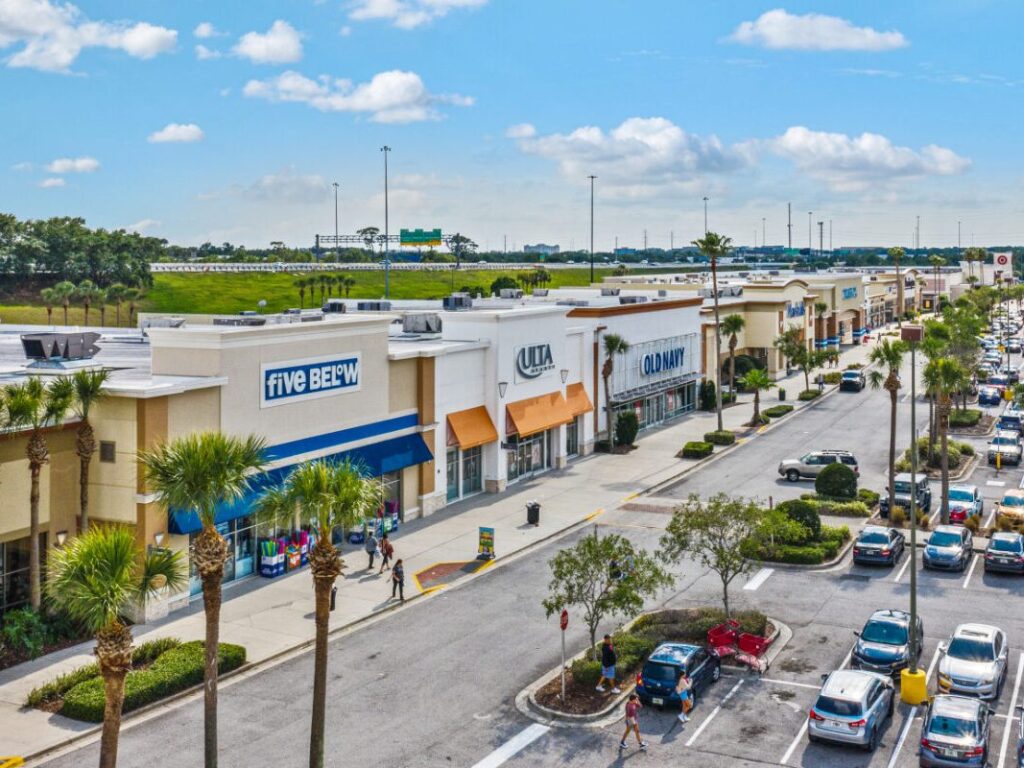Earlier this year, CTO Realty Growth also acquired The Marketplace at Seminole Town Center in Sanford, Fla. Image courtesy of CTO Realty Growth
CTO Realty Growth has acquired three outdoor shopping centers totaling approximately 1.2 million square feet for $137.5 million.
The portfolio includes Carolina Pavilion in Charlotte, N.C., Millenia Crossing in Orlando, Fla., and Lake Brandon Village in Tampa, Fla. The previous owner of the property was SITE Centers, according to CommercialEdge.
CTO Realty Growth’s recent sale of Jordan Landing in West Jordan, Utah, for $18 million has increased its real estate portfolio square footage by approximately 19 percent and annual base rent by 14 percent compared to June 30th.
Related article: Retail owners gain influence
Additionally, since the start of the year, CTO has completed $230 million in acquisitions, including structured investments, and $38 million in divestitures. One of the acquisitions this year was a 318,000 square foot retail power center in Sanford, Florida, a submarket of Orlando.
Millenia Crossing is also located in a prime retail area in Orlando, and Lake Brandon Village adds another property with a grocery store anchor to CTO’s portfolio. With the sale of Jordan Landing, all of the company’s properties will be in markets in the southeastern and southwestern United States.
A “soft landing” for the economy and revitalization of the retail sector
Mark Sigal, CEO of Datex Property Solutions, told Commercial Property Executive that despite concerns around the economy, financial markets and their impact on consumer spending, everything we’re seeing from a data perspective suggests the economy is having a soft landing and outdoor retail remains strong in all markets, including the Southeast.
Rent collections, retail sales and merchant health indicators (also known as occupancy costs) at thousands of shopping centers and thousands of retailers contribute to a positive outlook for the sector.
“Rent collection trends have remained broadly stable and on a year-over-year basis over the past three months,” Sigal said. “No part of the country is deviating significantly from this trend, and if there is a weakness, it is in independently operated housing. But even then, the variance is less than one percentage point.”
Additionally, Sigal noted that retail sales and store health indicators (the so-called “oxygen” for store survival) are showing sales growth and occupancy costs shrinking across 65% of the more than 20 retail verticals tracked by Datex, trends that speak to the health of outdoor retail, he added.
Related article: Retail always comes back—and with a new twist
“Furthermore, vacancy rates remain at historically low levels and the ongoing shortage of new retail space suggests a seller’s market remains for retail property owners. With interest rates expected to be reduced in the near future, outdoor retail remains a favored asset class,” Sigal concluded.
Jenny Shuman, vice president and senior director of leasing at PEBB Enterprises, largely agreed, telling CPE that open-air shopping centers remain attractive to retailers and consumers.
“Retailers are attracted to these projects when opening stores because they often have a good mix of co-tenants, including restaurants, retailers, big-box stores and local boutiques,” Shuman said.
“I see poorly designed and commercialized open-air projects being acquired, reoccupied, redesigned and working with a second or third owner who has a new perspective and budget. Unfortunately, sometimes a few occupants fail to understand what kind of retail or restaurants will work in their particular demographic area.”
Lauren Ball, chief operating officer at Westwood Financial, told CPE that the CTO Realty Growth deal highlights the strong demand and potential in the area.
“The market for outdoor shopping centers remains strong as the Southeast continues to experience population growth and economic expansion,” Ball said. “The Southeast’s favorable demographic and economic outlook makes it an attractive region for continued investment and development in the outdoor shopping center sector.”
Outdoor Attractions
David McCullough, principal landscape architect at McCullough Landscape Architecture, told CPE that open-air shopping centres are growing in popularity as people seek new ways to enjoy vibrant, outdoor, mixed-use environments away from urban centres.
“People see these outdoor centers as places that offer the same luxuries as downtown cores without many of the social and infrastructure problems that are endemic in most urban areas,” McCullough said, highlighting the appeal of such facilities.
“Some of these centers are even renting out their outdoor space at rates comparable to the indoor space,” he added. “Interest in this space is spreading beyond the property lines, and some smart owners are using this model to increase property values in their neighborhoods.”



